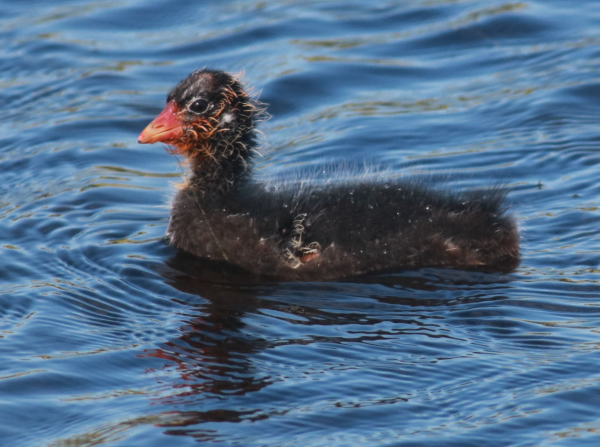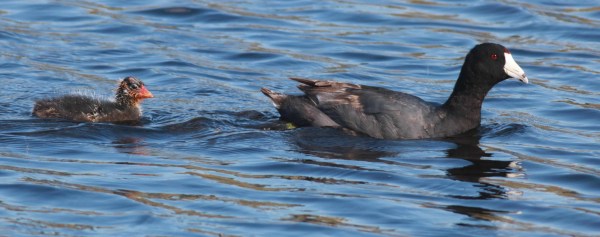
The amount of coloration of young American Coots dictates the amount of food they receive from adults (photos by Paul Konrad ).

Adult American Coots tend to pick a favorite colorful hatchling to feed more.
|
American Coots are somewhat drab waterbirds with gray and black feathers and a mostly white beak that are relatively common in wetlands in North America. Coot hatchlings, however, have bright orange and red coloration on feathers on their neck and head, plus their beak. A new study explains how this bright coloring of coot hatchlings fits into the reproductive strategy of adult pairs. For more than 20 years biologists have been chipping away at understanding American Coot reproductive behavior, and this is another interesting aspect of that study.
Previous research showed coot pairs preferentially feed more brightly ornamented hatchlings over hatchlings whose plumage has been manipulated to be less colorful, giving the ornamented hatchlings a survival advantage. This parental preference within coot broods can drive the evolution of ornamentation in the offspring, just as female mate choice in some birds can result in ornamented males in the context of sexual selection (peacocks being a classic example).
However, left unresolved by the earlier research was why coot adults would have a preference for ornamented offspring in the first place, and whose fitness interests are served by the ornamentation, said Bruce Lyon, professor of ecology and evolutionary biology at the University of California Santa Cruz and first author of the new study, published recently in the Proceedings of the National Academy of Sciences.
At their field study sites in British Columbia, Lyon and co-author Daizaburo Shizuka from the University of Nebraska Lincoln conducted studies on nesting American Coots. For years, Dr. Lyon has studied birds that lay eggs in the nests of other birds. Called brood parasitism, this behavior is rampant among American Coots, with most females laying some eggs in the nests of other coots in addition to laying a clutch of eggs in their own nest.
Hatchling mortality mostly takes place during the first 10 days after the eggs hatch, when the adults don’t show feeding preferences and feed the hatchling that reaches them first when they have food. The first coots to hatch get a head start on growth and development, so through competition most of the mortality is among the later-hatched offspring.
Everything changes, though, about 10 days after the last hatchling emerges from its egg. At that point, the adults start controlling food allocation to make sure all the hatchlings in the brood get enough food to survive. Each adult chooses a favorite that gets preferential feeding, which becomes the most colorful younger hatchlings. Meanwhile, their larger early-hatched siblings endure a form of parental aggression called tousling (shaking them by the back of the neck) to keep them from hogging too much food. The favored hatchlings are initially much smaller than their siblings, but the extra feeding allows them to catch up and sometimes exceed the others in body mass the research showed.
The adult male and female divide the brood, with each adult exclusively feeding their half of the brood, and picking a favorite, explained Dr. Lyon. Color predicts which hatchling they choose, so the ornamentation may serve as a signal to tell them which one needs the most help.
The effect of laying order on coloring also explains why the parasitic eggs laid in other nests are less colorful. The eggs a female lays in a neighbor’s nest are the first ones in her laying sequence, so they get the least pigment.
“They’re complicated birds. For over 20 years, we’ve been chipping away at understanding their reproductive behavior, and this is another interesting aspect of that,” Lyon said. Dr. Lyon described parental preferences for ornamented chicks in a 1994 Nature paper, and he and Dr. Shizuka described coot parents’ food allocation strategies in a 2013 Ecology Letters paper.
Journal Publication Reference: Bruce Lyon and Daizaburo Shizuka. Extreme offspring ornamentation in American coots is favored by selection within families, not benefits to conspecific brood parasites. Proceedings of the National Academy of Sciences, 2019.
For the original story, refer to the ScienceDaily article at https://www.sciencedaily.com/releases/2019/12/191231111817.htm